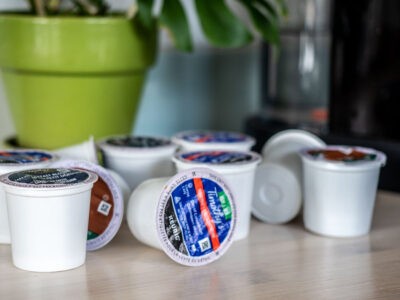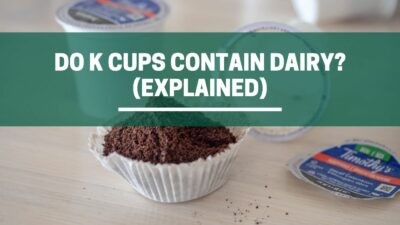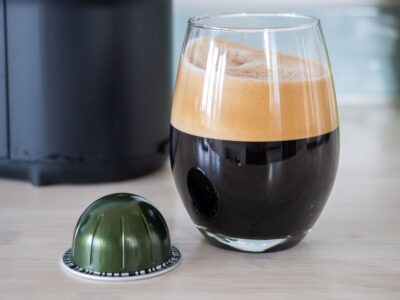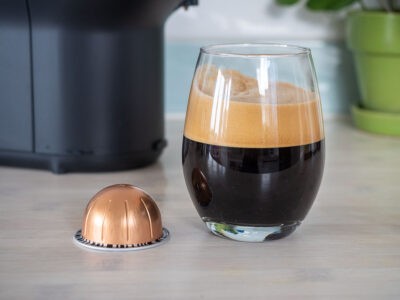Aeropress Guides
How Much Caffeine Is In An Aeropress Coffee
I love my Aeropress coffee maker. But, I noticed I wasn’t feeling as ‘wired’ as i usually do after an espresso coffee.
I decided to figure out exactly how much caffeine there is in a standard Aeropress brew.
A standard Aeropress coffee using 15 grams of ground coffee gives you 80-160mg of caffeine per cup, but, this varies with many factors. These include brew time, bean type, water temperature, coffee-to-water ratio, roast, and how fine or coarse your grounds are.
In this article, we’ll simplify all these concepts so you’re able to understand how much caffeine went into your coffee and what changes you can make to increase/decrease it going forward.
Why Listen To Us? Well, because we KNOW coffee! In fact, we make our own coffee, coffee machine cleaners, and reusable capsules which we've sold to over 41 countries. Our team ouf experts include Tristan (an engineer), Claire (a food writer) and Richy (a barista). So, whether you're looking for a recipe or repair guide, we've got you covered 💚
Table of Contents
How Much Caffeine Is There In Coffee Beans?
Ok, so first we need to understand what’s in the coffee we’re using.
Here’s a table summarising how much caffeine there is in coffee beans according to type (Arabica and Robusta) and by weight.
| Coffee Used (grams) | Average Caffeine – Arabica | Average Caffeine – Robusta |
|---|---|---|
| 1g | 10mg | 22mg |
| 10g | 100mg | 220mg |
But unfortunately, it’s not quite that simple.
The amount of caffeine found in coffee beans varies depending on the type of bean, the roast, the water temperature, the coffee-to-water ratio, and the grind of the beans. Here’s an explanation of each of these factors.

1. Bean Type/ Variety
There are two main types of beans used to make coffee: Arabica and Robusta. Arabica has almost half the amount of caffeine as Robusta. The amount of caffeine you’d get in a gram of Arabica beans is about 10mg, and Robusta would give you 22mg of caffeine per gram.
Arabica coffee is far more flavorful and aromatic than Robusta and as a result, good cafes will likely exclusively use Arabica coffee.
We’re going to assume you’re also using an arabica bean.
2. Roast
Contrary to popular belief, both light and dark roasts have the same amount of caffeine.
The difference is the weight by volume between the two. The longer the roast master roasts the beans, the more water each bean loses its water content, therefore, making it less dense.
Darker roasts are roasted longer to achieve a deep brown/black color, to increase their bitterness, and to create rich toasted and chocolaty notes.
In fact, the density between light and dark coffee beans can vary as much as 29% (source). If you measure your coffee by volume, e.g. a scoop of coffee, then this means you’ll get less caffeine with a dark roast. If you measure your coffee by weight, then the caffeine will be exactly the same between roasts (source).
This is how people got the notion that dark roasts have more caffeine than light roasts.
3. Coffee-water ratio
A standard cup of Aeropress coffee uses 15g of coffee to 235ml of water. If you were to increase the number of grounds while using the same amount of water, you’ll obviously end up with more caffeine in your coffee

4. Water Temperature
Caffeine is highly soluble in hot water.
We can assume that almost all of the caffeine is extracted when using hot water. If using cold water, your caffeine concentration will be less.
5. Grind
A finer ground allows the water to easily extract all coffee compounds required for a full-bodied drink. This is because there is an increased surface area for the water to move around and interact with the beans. When using coarsely ground beans, you’d either have to increase the amount of coffee you’re brewing or let your coffee steep longer than usual to get the desired brew.

How Much Coffee Is Used In An Aeropress?
A typical Aeropress uses up to 15-25g of coffee. Not only is this amount based on how strong a cup of coffee you desire, but also because some of the compounds that contain the flavonoids are solids, which get trapped by the filter. So, if you’re looking to make a nicely balanced coffee, aim for between 15-25g of coffee beans per cup.
So, How Much Caffeine Is There In A Cup Of Aeropress Coffee?
A standard 8-ounce Aeropress brew has 80-160mg of caffeine.
The exact caffeine extraction efficiency comes down to how long the coffee is left to steep, the temperature of the water, the brew ratio and the grind size. For example, steeping for the recommended 30 seconds will yield less caffeine than if you were to leave it for longer, say, 60 – 90 seconds.
| Strength | Estmated Caffeine Amount |
|---|---|
| Weak (10g Coffee) | 80mg |
| Average (15g Coffee) | 120mg |
| Strong (20g Coffee) | 160mg |

Frequently Asked Questions
Here are the answers to some questions we’ve had asked in the past. If you’re unsure of anything, please let us know in the comments below.
Q. Does Aeropress have more caffeine?
Aeropress has the same amount of caffeine as coffee brewed by other methods. Whether (or not) your device will produce a super-caffeinated cup mostly depends on the coffee-water ratio.
Q. Is Aeropress stronger than espresso?
Aeropress is not stronger than espresso. It does brew a strong cup of coffee which you can dilute according to your preference, but it’s not as intense and thick as an espresso. If you’re aiming for a coffee that closely resembles an espresso, consider adding more grounds to your Aeropress.
Conclusion
Aeropress yields the same amount of caffeine as a regular cup brewed from the same amount of coffee beans.
The major difference comes when you decide to use Robusta as opposed to Arabica beans. Arabica beans have about 100mg of caffeine per 10 g, while Robusta has 220 mg of caffeine per 10 g of beans. Also, a dark roast will generally produce a slightly higher caffeine content because its weight by volume is equivalent to a light roast.
So, now that you are armed with this information, you can confidently brew an Aeropress coffee while being aware of your caffeine intake.







